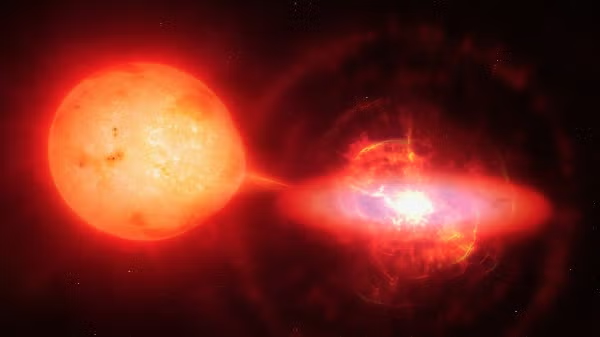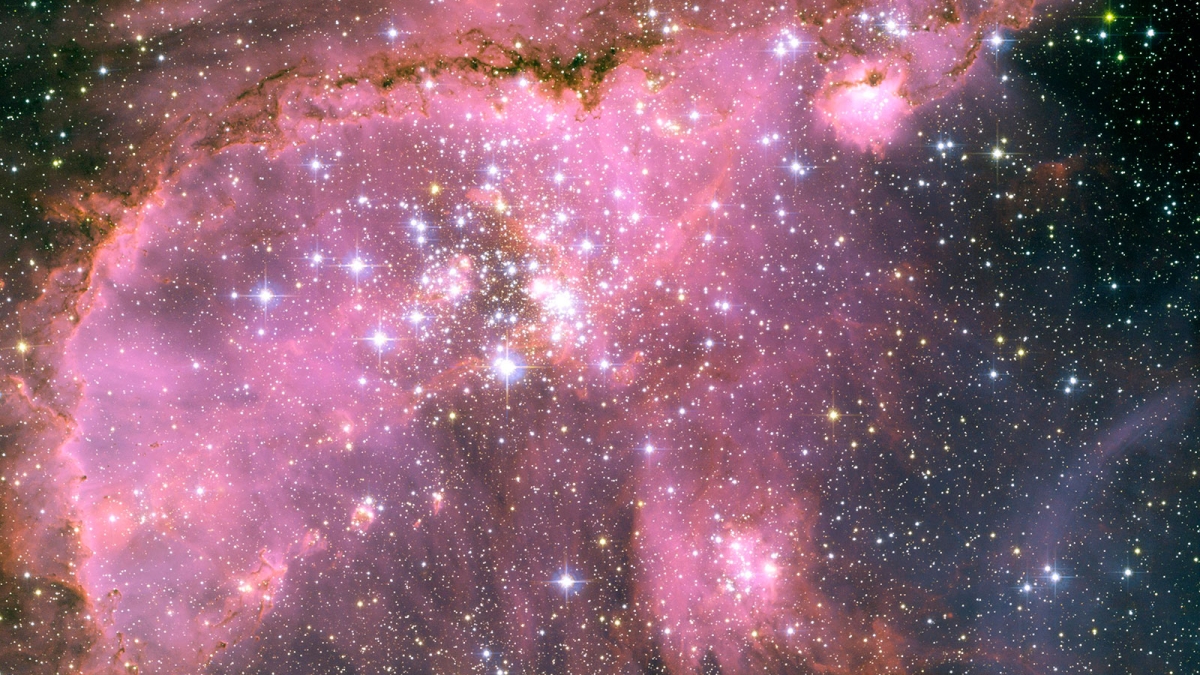As humans reach out technologically to see if there are other life forms in the universe, one important question needs to be answered: When we make contact, how are we going to handle it? Will we feel threatened and react in horror? Will we embrace it? Will we even understand it? Or, will we shrug it off as another thing we have to deal with in our increasingly fast-paced world?
“If we came face to face with life outside of Earth, we would actually be pretty upbeat about it,” said Michael Varnum, Arizona State University assistant professor of psychology. “So far, there’s been a lot of speculation about how we might respond to this kind of news, but until now, almost no systematic empirical research.”
In a pilot study, Varnum and his colleagues analyzed language in newspaper articles about past potential extraterrestrial life discoveries. Through the work, Varnum aimed to address the nature of reactions to extraterrestrial life by analyzing reactions using a software program that quantifies emotions, feelings, drives and other psychological states in written texts.
Varnum was scheduled to present his findings during a press briefing on the future for humanity in space Feb. 16 at the annual meeting of the American Association for the Advancement of Science (AAAS) in Austin, Texas.
Also presenting was Lindy Elkins-Tanton, director of the School of Earth and Space Exploration at ASU, co-chair of ASU’s Interplanetary Initiative and principal investigator of the NASA Discovery Mission Psyche, who was scheduled to talk on the future for humanity in space; and Paul Davies, ASU Regents' Professor in the Department of Physics and director of the Beyond Center for Fundamental Concepts in Science. The press briefing was slated for 1 p.m. Central time (noon Arizona time) Friday, available for live-streaming: https://www.eurekalert.org/aaasnewsroom/2018/briefings/.
Lindy Elkins-Tanton, Paul Davies and Michael Varnum address the press at a briefing at the AAAS annual meeting in Austin, Texas, on Feb. 16. Photo by Leslie Minton/ASU
The articles in Varnum's pilot study focused on the 1996 discovery of possibly fossilized extraterrestrial Martian microbes; the 2015 discovery of periodic dimming around Tabby’s Star, thought to indicate the presence of an artificially constructed “Dyson sphere”; and the 2017 discovery of Earth-like exoplanets in the habitable zone of a star. The pilot study found that language in the coverage of these events showed significantly more positive than negative emotions.
In a separate study, the team asked more than 500 different participants to write about their own hypothetical reactions and humanity’s hypothetical reaction to an announcement that extraterrestrial microbial life had been discovered. Participants’ responses also showed significantly more positive than negative emotions, both when contemplating their own reactions and those of humanity as a whole.
“I would have some excitement about the news,” one participant said. “It would be exciting even if it was a primitive form."
In another study, Varnum’s group presented an additional sample of more than 500 people with past news coverage of scientific discoveries and asked them to write about their reactions. The participants were divided into two groups. In one group, participants read a past article from The New York Times describing possible evidence of ancient microbial life on a Mars meteorite. The second group of participants read an article from the Times describing the claimed creation in a lab of synthetic human-made life. Here too, the team found evidence of significantly more positive than negative emotions in responses to the claimed discovery of extraterrestrial life, and this effect was stronger in response to reading about extraterrestrial life than human-made synthetic life.
"This discovery shows that other planets have the ability to have life on them,” a participant said. “It’s a very interesting and exciting finding that could be only the beginning.”
In unpublished results presented at the conference, Varnum analyzed recent media coverage of the possibility that the interstellar Oumuamua asteroid might actually be a spaceship. Here too, he found evidence of more positive than negative emotions, suggesting that we may also react positively to the news of the discovery of evidence of intelligent life from elsewhere in the universe.
Varnum said the studies show that “taken together, this suggests if we find out we’re not alone, we’ll take the news rather well.”
The results of the first three studies were published Jan. 10 in Frontiers in Psychology and analysis of reactions to Oumuamua were presented at AAAS for the first time. ASU doctoral students Hannah Bercovici and Jung Yul Kwon, and ASU alumna Katja Cunningham, assisted Varnum in the research.
Paul Davies and the origins of life
Are we alone in the universe? Few questions have captured the public imagination more than this. Yet to date we know of just one sample of life, that which exists here on Earth.
Although there is plenty of habitable real estate out there, “habitable” is not the same as “inhabited,” says noted cosmologist Davies. Because nobody knows how non-life transitioned to life on Earth, it is impossible to estimate the odds of it springing forth elsewhere in the universe.
Davies will present his findings during an AAAS press briefing Feb. 16.
“During my career, opinion has shifted from life’s origin being a bizarre fluke unique in the universe (‘almost a miracle’ in the words of Francis Crick), to the belief that the universe is teeming with life (‘a cosmic imperative’ in the words of Christian de Duve),” Davies said. “How can we settle the matter? For several decades astronomers have been sweeping the skies with radio telescopes hoping to stumble across a message from ET. So far they have been met by an ‘eerie silence.’”
“Meanwhile, astrobiologists have considered how signatures of microbial life might be detectable in the solar system or in the atmospheres of extra-solar planets,” Davies added. “If life really does form readily in Earth-like conditions, it should have started many times right here on Earth, so we should look for a ‘shadow biosphere’ of life, but not as we know it, under our very noses.’”
Davies is a cosmologist, theoretical physicist, astrobiologist and best-selling author. His latest book "The Eerie Silence” is a celebration and critique of the search for cosmic company.
Davies is a member of the Breakthrough Listen Committee and formerly chaired the SETI Post-Detection Task group of the International Academy of Astronautics. He was the first person to champion the idea that life on Earth may have originated on Mars and transferred here in impact ejecta. Davies is director of the Beyond Center at ASU that researches how life began in terms of the organization of information in complex networks — the software of life. His forthcoming book “The Demon in the Machine” is a penetrating look at the power of information to explain the physics of living matter.
Lindy Elkins-Tanton and the future for humanity in space
Given a growing eagerness to open space-related commodity and travel markets, it is clear that the future of humans in space will be very different from the past. Technological advancement has driven the discussion so far, but new questions are beginning to emerge as federally funded research universities and companies such as Virgin Galactic and Blue Origin expand the frontiers of space travel.
At the briefing, Elkins-Tanton was to introduce ASU’s Interplanetary Initiative, a public-private-university partnership seeking to build the future of humans in space. She also provided an update on the ASU-led NASA Psyche Mission.
The briefing included opening remarks for the symposium "Is There a Future for Humanity in Space?" which is scheduled for 10 a.m. (CST) Saturday, Feb. 17.
The symposium, moderated by Elkins-Tanton, will include Varnum and Davies, as well as Blue Origin business development manager Erika Wagner. Varnum will give a talk called, “What Happens When Everyone Finds Out?” and Davies will speak on "The Search for Life Beyond Earth."
The panel will address the constellation of issues that democratization of space brings to the fore, including how governments will compete to ensure geographically distributed space access; how going into space may change humanity; and how the space industry will integrate these questions with their bottom lines. Speakers will also consider the role of NASA in stewarding the future of space travel. Session attendees will engage in a discussion about how scientists, students, policymakers, ethicists, lawyers and interested members of the public may participate in shaping a democratized space future.
“We believe that humanity’s future in space is inevitable. To get there, we must create a critical mass of people who are attracted to the unknown, seek out unsolved problems, and are willing and able to find solutions,” said Elkins-Tanton.
Karin Valentine and Skip Derra contributed to this article.
More Science and technology

Stuck at the airport and we love it #not
Airports don’t bring out the best in people.Ten years ago, Ashwin Rajadesingan was traveling and had that thought. Today, he is an assistant professor at the University of Texas at Austin, but back…

ASU in position to accelerate collaboration between space, semiconductor industries
More than 200 academic, business and government leaders in the space industry converged in Tempe March 19–20 for the third annual Arizona Space Summit, a statewide effort designed to elevate…

A spectacular celestial event: Nova explosion in Northern Crown constellation expected within 18 months
Within the next year to 18 months, stargazers around the world will witness a dazzling celestial event as a “new” star appears in the constellation Corona Borealis, also known as the Northern Crown.…



